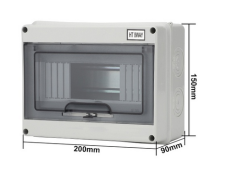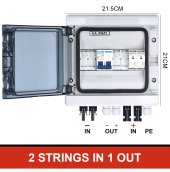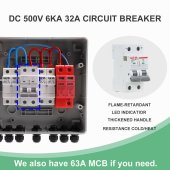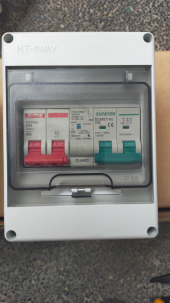burgerking
New Member
I currently have these IP65 8P plastic MCB box.
It is the most available MCB box locally and getting a bigger box from China will take weeks.

I intend to turn this into a 2 String PV disconnect + Surge Protector to be installed near the Inverter.
I will be adding 2 pairs of SPDs and 2 pairs of DC Breakers (or Fuses).
There is hardly 3 cm of space at the top and bottom of the MCB to route wires around.
METHOD1:
I drill 8 4mm holes, and match the location of these holes with the MCB ports such that I don't have to route the wires on the inside but from the outside.
I can add rubber silicon grommet to add a little water seal. Or dab of silicon sealants...

METHOD2:
Or I install PG7 Cable Glands or MC4 connectors at the bottom.
Match the location of these Glands to the MCB ports.
METHOD3:
Or simply install larger PG13.5 cable glands under each MCB/Fuse.
Two wires passes through each Cable Gland. it is thus far the EASIEST method.
On another BOX for AC disconnect, I tried Method2... Too much work IMO.
There has got to be a simpler solution.
It is the most available MCB box locally and getting a bigger box from China will take weeks.

I intend to turn this into a 2 String PV disconnect + Surge Protector to be installed near the Inverter.
I will be adding 2 pairs of SPDs and 2 pairs of DC Breakers (or Fuses).
There is hardly 3 cm of space at the top and bottom of the MCB to route wires around.
METHOD1:
I drill 8 4mm holes, and match the location of these holes with the MCB ports such that I don't have to route the wires on the inside but from the outside.
I can add rubber silicon grommet to add a little water seal. Or dab of silicon sealants...

METHOD2:
Or I install PG7 Cable Glands or MC4 connectors at the bottom.
Match the location of these Glands to the MCB ports.
METHOD3:
Or simply install larger PG13.5 cable glands under each MCB/Fuse.
Two wires passes through each Cable Gland. it is thus far the EASIEST method.
On another BOX for AC disconnect, I tried Method2... Too much work IMO.
There has got to be a simpler solution.








